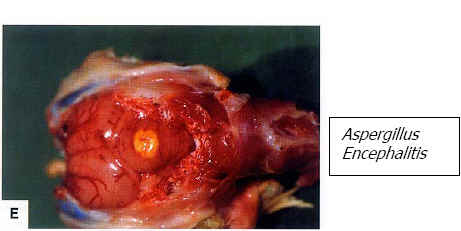



Poultry Health: Aspergillosis
By Hybro - With our fascination for new or emerging disease in poultry, it is easy to overlook old enemies. Yet fungal infections in poultry still do occur periodically and can lead to serious economic losses, especially in very young chickens. And with the introduction of in-ovo techniques, the risk of aspergillosis infections in the hatchery has increased.
Aspergillosis: the mould
There are approximately 600 subtypes of aspergillus of which a. fumigatus and a. flavus are the most common. Spread is worldwide and should be considered as a commensal, as it is found everywhere in nature due to its basic nutrient requirements. While the optimum temperature for growth is 40°C, aspergillus thrives anywhere from 10-60°C, and the higher the humidity, the better it grows.
It is quite resistant to disinfection. Most products used today contain sulphur, copper or formalin components, and as a fungicide, enilconazole is most common. In infection, several toxins are produced, for which the pathogenecity in poultry is not yet fully apparent, although in turkeys we know that the gliotoxins produced by aspergillosis are toxic and immunosuppressive. The fungi produce spores-conidia with a diameter of 2-3 µm.
The disease and its symptoms
Due to the minute size of the spores, these present a risk when inhaled, as they pass the barriers in the upper respiratory tract to infect the lung and air sacs directly.
While the disease is most commonly found in very young birds up to 14 days of age, mature birds are by no means immune to the effect of Aspergillosis.
Pneumonia and air-sacculitis are the most common findings. Sometimes dermatitis, osteomycosis, ophtalmitis and encephalomyelitis are found. Source of infection is usually by the inhalation of spores in the hatcher, which is where the name “brooder pneumonia” comes from. Immuno-suppression by whatever cause can lead to an explosion of the incidence. The post mortem findings are typical: white caseous nodules of 1-2 mm in the lungs and 1-5 mm granuloma in the air sacs. Incidentally these white nodules can be found in other organs.
Transmission
There is no true vertical transmission, but the eggshell itself can be a source of infection (lateral transmission). As a saprophyte, aspergillus is not specifically a poultry pathogen, and therefore grows everywhere that conditions are favourable.
This means that on parent stock level, wet litter and wet nest shavings are sources for Aspergillosis. The eggshells become infected here and transfer the infection to the hatchery. Then during hatching, the ventilation system of the hatchery will become infected – and at the moment of hatch, the day old chicks will inhale the spores and develop pneumonia.
Using in-ovo techniques creates an added risk factor because, after injection, the puncture is not closed and there is direct contact of hatchery air with the egg mass.
Other sources in the hatchery include wet carton, which is also well known as a cause of infection, while on broiler level again, wet shavings are the main source of infection. Feed and water have only occasionally been found to act as such.
Therapy
In the case of an aspergillus outbreak, the first priority is to remove the source of the fungi – which means starting with the parent stock farm. Automatic nests here have proven advantageous in two ways: the number of floor eggs is generally reduced and the infection level of the hatching eggs is far lower than in conventional systems. Formalin flakes are sometimes used to keep aspergillus under control in the nests.
Next, look at the hatchery, in particular the ventilation system and any possible other secondary sources of infection.
Cleaning up the ventilation system is not always easy. Be aware of dead ends in the channels where water (condensation) and fluff can collect. For disinfection here, formalin is most frquently used.
In the setters and hatchers, either formalin or enilconazole (clinafarm®) can be used. The enilconazole products have no negative effects on embryo development.
On bird level, sprays and drinking water therapies are sometimes used, including Iodine and enilconazole products, either by aerosol or spray. However results here are often disappointing.
Conclusion
Aspergillosis can be prevented by vigilance and by taking the correct actions to ensure that there is no environment present or created in which Aspergillosis, as a common and prevalent fungal spore, may thrive to infect your flocks.
Be mindful that the risk increases with the use of in-ovo techniques: all the more reason to be extra-attentive to managing any warm, damp or humid conditions in the hatchery.


Source: Hybro B.V. - June 2005








